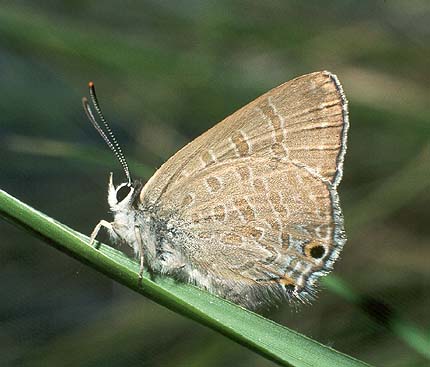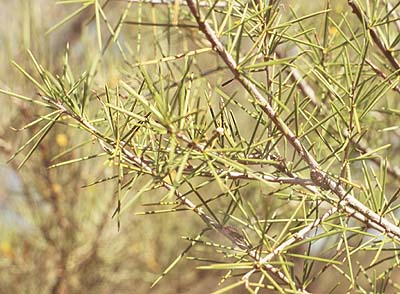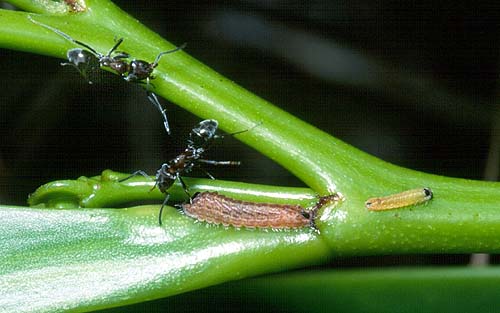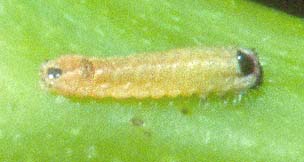-
Larval Food Host
-
Acacia spp including A. anceps (Port Lincoln wattle),
A. aneura aneura (mulga), A. calamifolia (wallowa),
**A. dealbata (silver wattle), A. mearnsii (black wattle),
A. melanoxylon (blackwood), A. pendula (Boree or Weeping Myall),
A. pycnantha (golden wattle), A. retinodes (Wirilda),
**A. saligna (golden-wreath wattle), A. tetragonophylla (dead finish),
A. victoriae victoriae (elegant or bramble wattle) (Mimosaceae);
Daviesia benthamii (Fabaceae);
Senna spp incl.
S. artemisioides coriacea (punty bush or desert cassia),
S.a. filifolia (fine-leaf desert senna),
S.a. petiolaris (desert cassia - glabrous form) (Caesalpiniaceae).
The larvae eat the young leaves of the hostplant. Older larvae in the inland pastoral areas will
also eat the waxy coating of scale that sometimes infest the hostplant Acacia aneura.
Their use of hostplant is usually quite specific to a certain region. In the coastal and
higher rainfall areas they use Acacia, while in the dry inland areas they tend to
use both Senna and Acacia. Sometimes they will only use Senna even
though the Acacia which they use elsewhere may be growing adjacent to the Senna.
Even their use of Acacia can be very specific within each colony, often using only
one type of Acacia.
-
Larval Attendant Ant
-
Larvae are usually attended by numerous small black or dark brown and black ants
Iridomyrmex spp (rufoniger group in NSW). In
the Adelaide Hills they can also be attended by a large black
Dolichoderus sp (scabridus species group) having
a coconut smell, but these ants only attend to the larvae, not the pupae.
In the Mid North and Flinders Ranges Regions, Jalmenus icilius cohabits with
a close relative J. lithochroa, and both use bramble wattles as a hostplant.
However, they never use the same bramble wattle for a hostplant, as the attendant
ant for J. lithochroa is the large, ferocious meat-ant, which will quickly
make a meal of any J. icilius larvae or butterfly they come across.
-
Eggs
-
-
Larvae
-
Larvae remain exposed on the hostplant in full sun, attended by numerous ants,
and can endure considerable day time temperatures exceeding 40°C.
Mature larvae 18-25 mm long.
-
Pupae
-
10-12 mm long.
-
Flight Period in South Australia
-
In the southern areas it flies during the warmer months from October to May,
with usually a main flight in late spring to early summer, and another smaller
flight in early autumn. In these areas the colony mainly over-winters as eggs,
which hatch in September and October. There are also some over-wintering pupae,
which produce an early spring flight. There are then continuous broods over the
warmer months, which can be completed in about 8 weeks. In the far north of the
state where survey data is incomplete, the flight records include the winter months.

-
Distribution
-
The butterfly has been found through most of mainland South Australia. The known
distribution includes Wardang Island, but not Kangaroo Island or the Southeast
Region. However, as its known range includes western Victoria, it is likely its
range will eventually be found to extend to the Southeast parts of South Australia.
Its Australia wide range extends through much of the temperate and subtropical
latitudes of mainland Australia, mostly within the dryer shrubland and woodland
areas. It is rare or absent in the wet coastal regions of the eastern states.

-
Habitat
-
It can be found wherever its hostplants occur, and these are common and widespread,
being present in most habitats. It prefers very open woodland habitat.
-
Conservation Status in South Australia
-
Although widely distributed, it is a rare butterfly in the southern settled areas,
being found only in conservation parks and reserves. It is locally more common in
the northern pastoral region.
-
Threats
-
The butterfly occurs in discrete colonies and is therefore highly vulnerable to any
detrimental process, particularly bushfires and the application of aerial insecticides.
There is probably a lower limit to the size of the vegetation remnant in which the
colony can survive.
-
Conservation Strategy
-
As there is a very strong association with ants, there is probably not a lot that can
be done in the way of re-establishing the butterfly in vegetation remnants lacking
the butterfly, and as the butterfly is not threatened it would be best to let the
butterfly make its own colonies. If the colony was threatened by development then it
might be possible to move it to another location by the transfer of the over-wintering
eggs. Known colonies in areas of agriculture and urban development need to be monitored
for detrimental processes.





